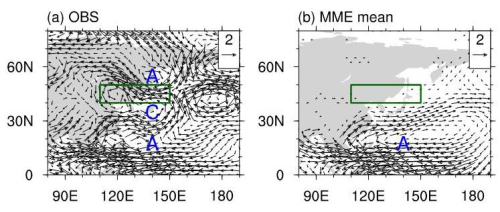The East Asia–Pacific (EAP) teleconnection pattern is the dominant mode of circulation variability during boreal summer over the western North Pacific and East Asia, extending from the tropics to high latitudes. However, much of this pattern is absent in multi-model ensemble mean forecasts, characterized by very weak circulation anomalies in the mid and high latitudes. This situation also appears in the forecast for the summer of 1998 (see figure), in which the Yangtze River basin experienced catastrophic floods, associated with an evident EAP pattern.

Low-level circulation in the (a) observation and (b) model forecast output (MME mean) in 1998. The “A” and “C” represent anticyclonic and cyclonic circulation anomalies, respectively. (Image by IAP)
A group of scientists from the Institute of Atmospheric Physics, Chinese Academy of Sciences, and the UK Met Office Hadley Center, investigated the absence of the EAP pattern in the extratropics using state-of-the-art coupled seasonal forecast systems. Their results indicate that the extratropical circulation is much less predictable, compared to the tropical component, owing to the large atmospheric internal variability.
"Not only the circulation, but also the surface temperature in eastern Russia, show low predictability”, says Dr. LI Chaofan, lead author of the study. “We found the extratropical EAP pattern varies closely with the anomalous surface temperatures in eastern Russia.”
This unpredictable circulation–surface temperature connection associated with the EAP pattern can also modulate the East Asian rainband, knowledge of which is beneficial for a better understanding of current seasonal forecasts and climate services over East Asia.
Reference
Lin, X., C. Li, R. Lu, and A. A. Scaife, 2018: Predictable and unpredictable components of the summer East Asia–Pacific teleconnection pattern. Adv. Atmos. Sci., 35, https://doi.org/10.1007/s00376-018-7305-5 .
Media contact: LIN Zheng, jennylin@mail.iap.ac.cn
